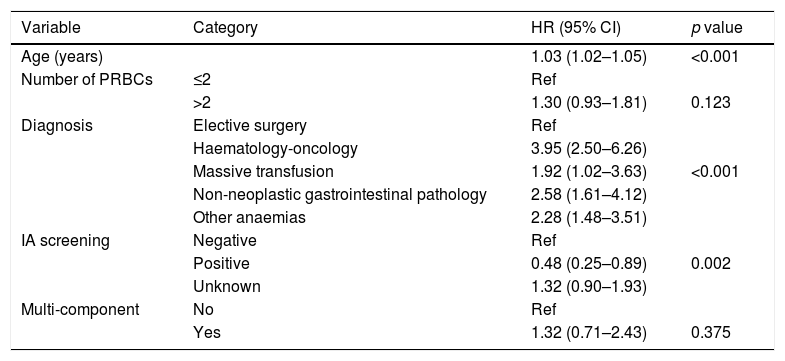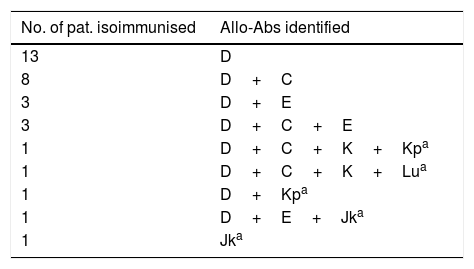To transfuse packed red blood cells isogroup ABO D is a usual transfusion practice. However, when there is not enough D-negative blood available, we can transfuse positive red blood cells to negative patients. Immunocompetent D-negative individuals may develop serologically detectable anti-D antibodies within 3 months after exposure to D-positive red blood cells.
Material and methodOver the last 18 years, we have experienced situations of D-negative blood cell scarcity. In these situations, we have applied a clinical assistance protocol, selecting patients with lower risk of alloimmunization and chronic transfusion requirements. We have retrospectively evaluated this policy for the use of D-positive red blood cells in D-negative patients, focussing on alloimmunization and mortality.
ResultsApplying the protocol, 3% of D-negative patients were transfused with D-positive units, with an alloimmunization rate of 12.3%. The rate of alloimmunization was higher in the younger age group and in those transfused with more units. No haemolytic reactions were reported. Mortality in the alloimmunized group was lower.
ConclusionThe use of D-positive red blood cells in selected D-negative patients does not induce adverse reactions, is a safe practice and allows saving of a product that is sometimes limited.
La transfusión isogrupo ABO D es la práctica transfusional habitual, sin embargo, cuando no se dispone de sangre D negativo puede ser preciso transfundir concentrados de hematíes D positivo a pacientes D negativo. Estos pacientes pueden desarrollar aloanticuerpos anti-D en los siguientes 3 meses a la exposición.
Material y métodoEn los últimos 18 años, hemos experimentado situaciones de escasez de sangre D negativo, en las que hemos aplicado un protocolo clínico asistencial, seleccionando s los pacientes según el riesgo de aloinmunización y de requerimientos transfusionales crónicos. Se realizó una recogida prospectiva de estos pacientes, analizando principalmente la aloinmunización y la mortalidad.
ResultadosTras las aplicación del protocolo se han transfundido unidades D positivo al 3% de los pacientes D negativo, con una tasa de aloinmunización conocida del 12,3%, siendo mayor en los pacientes más jóvenes y en aquellos que han recibido mayor número de unidades. No se detectaron complicaciones secundarias a la inmunización y la mortalidad en este grupo fue menor.
ConclusiónLa transfusión de hematíes D positivo a pacientes D negativo no solo es una práctica segura para pacientes seleccionados, sino que además permite optimizar el uso de un producto en situaciones de escasez.












